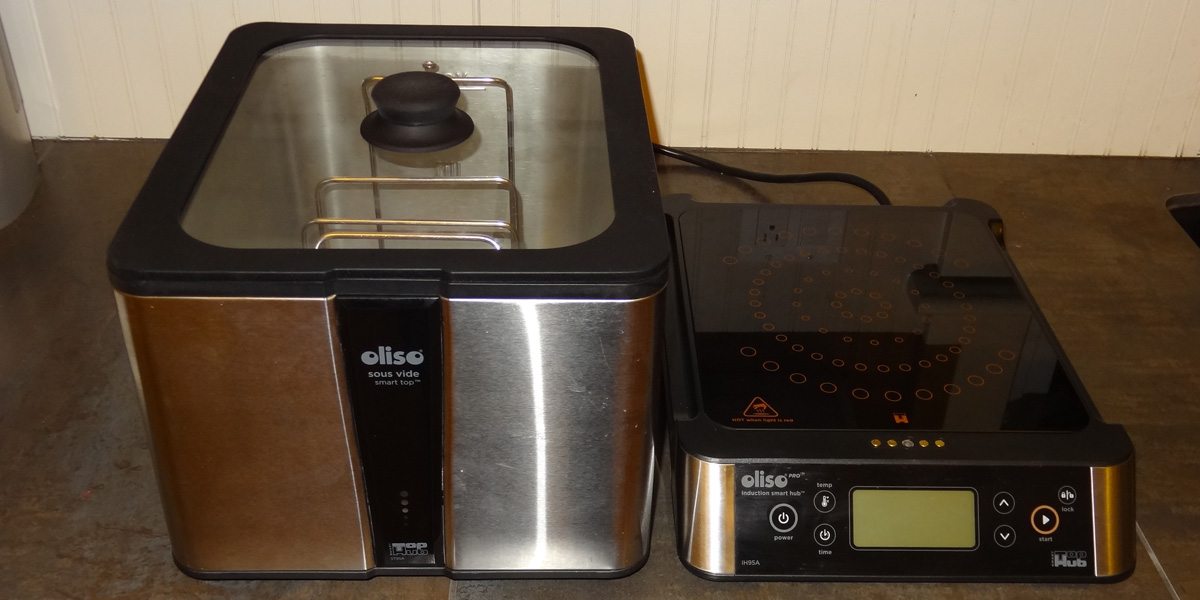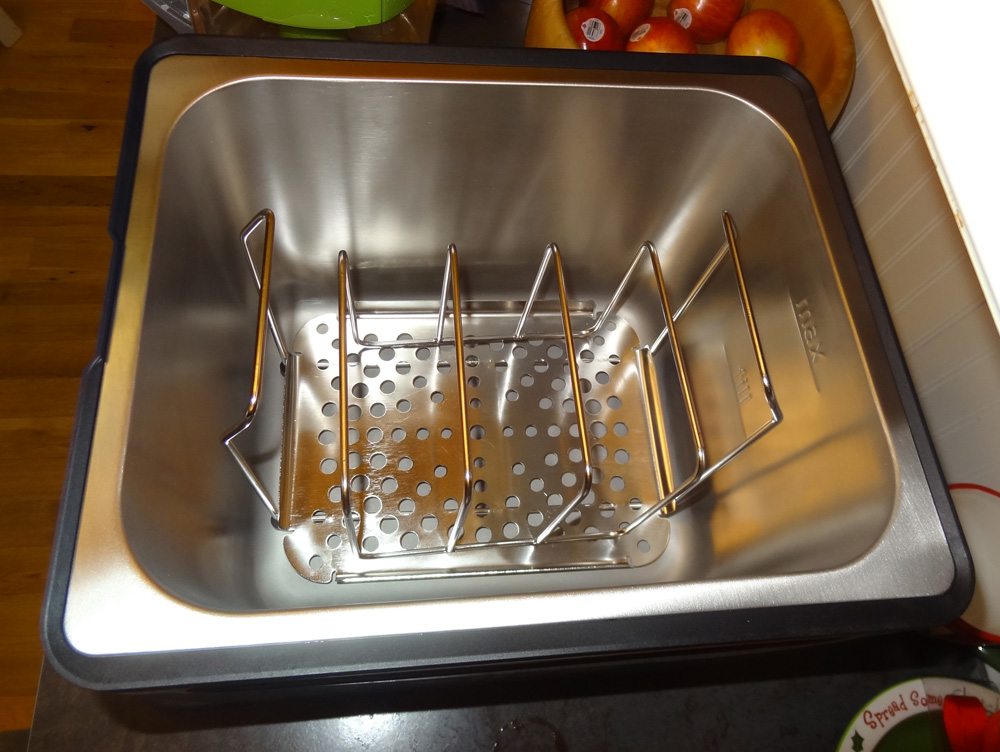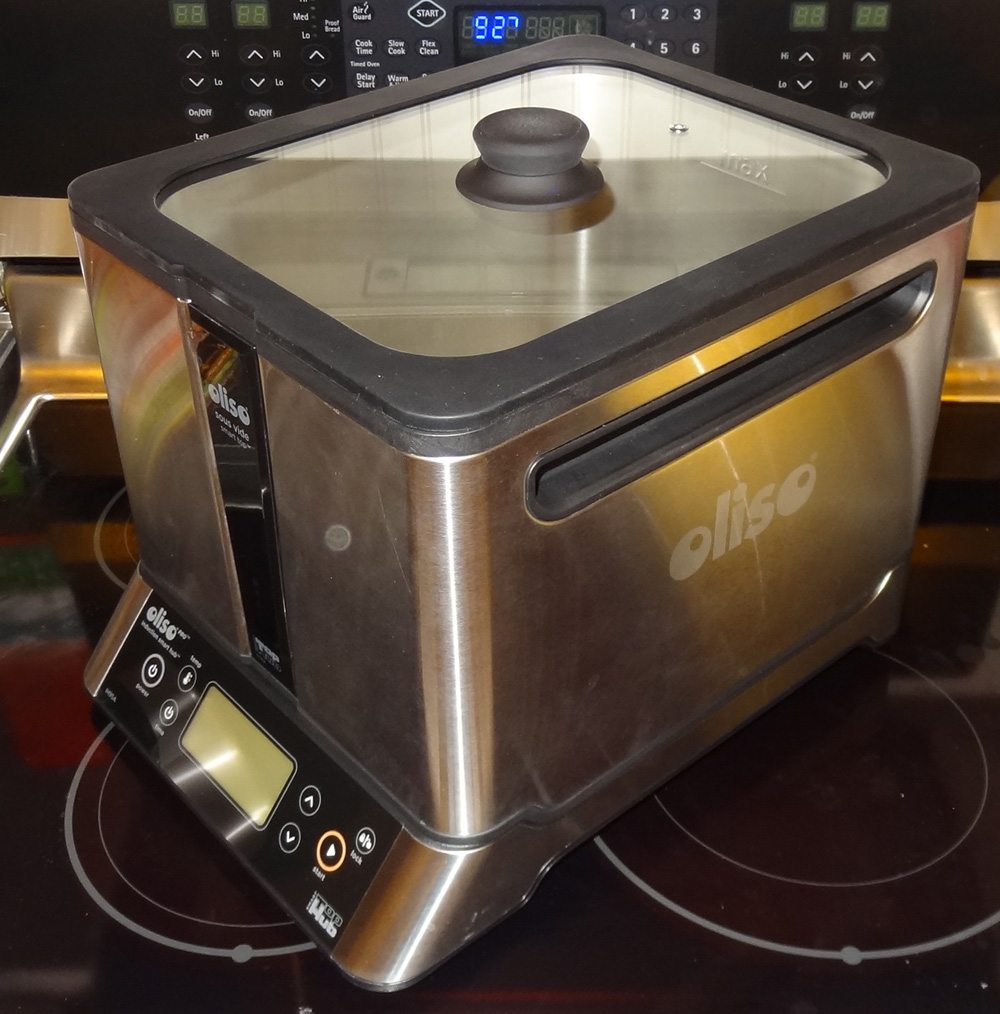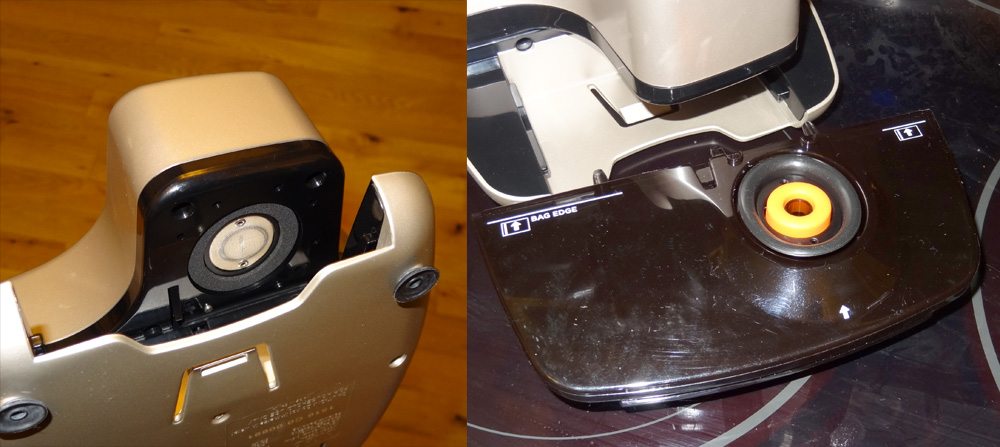
I’ve written before about sous vide cooking, from the poor man’s sous vide in a cooler to specialized devices like the Codlo and the Nomiku. Recently, I’ve gotten to try another set of appliances from Oliso: the SmartHub and the SmartSealer.
The SmartHub is an induction cooktop that can accommodate various accessories for different uses. For now, it comes with the Precision SmartTop, a tub that will hold liquids at a precise temperature. Oliso also ran a successful Kickstarter campaign in November to fund the SmartGriddle and a temperature probe that will work with the SmartHub, estimated to ship in May of this year. I got to try the SmartHub and Precision SmartTop, designed for sous vide cooking.
The SmartHub itself can be used as a cooktop. It’s a foot wide and about 15″ deep, with an angled face that includes control buttons and a small display screen. The sides and back are recessed to hold the various tops in place, and electrodes at the front automatically detect what top has been placed on it. In case you’re not familiar with induction cooktops, I wrote about our induction stove about five years ago and we still love it.

The Precision SmartTop is a large rectangular tub that fits onto the SmartHub. It has an 11-quart capacity, and comes with a two-piece rack and divider for holding your sous vide packages in place and keeping them off the bottom of the pot. The lid is tempered glass, with a small vent and a heavy rubber edge. The edge has a lip on the inside, so that water vapor collected on the lid can be directed back into the pot instead of dripping all over the counter.

The SmartTop has large, rubberized grooves along both sides for lifting, making it pretty easy to pick up (for when you need to dump out the water later). There are also some indicator lights on the front of it to show when it’s heating or if it has reached the set temperature.

When you put the tub onto the SmartHub, the hub automatically recognizes the tub and the display changes. You just fill the tub with water and set your desired temperature. The hub will beep when the temperature is reached, and a little icon indicates that it’s time to put the sealed bags in.

The SmartTop uses induction to heat up the water, so it’s fast–a good bit faster than the immersion circulators like the Nomiku. Plus, you’ve got a lid on the pot rather than an appliance sticking up out of the top of the pot. However, it relies on convection to circulate the water, rather than a little fan blade, so there isn’t as much water movement. Once you’ve got your food in the tub, you can also set a timer if you want to cook it for a particular length of time.

We made some steaks for our Christmas dinner, and when we were ready to eat, we pulled the steaks out of the bags and then seared them in a cast-iron skillet. What’s nice about the SmartHub is that you can pull off the tub and then put your skillet right on the hub. (Of course, in this picture the hub is sitting on our induction stovetop, but I wanted to try it out.) Of the four steaks we made, one was slightly overcooked, but it’s hard to say whether that’s because we had it in the pan too long or if the temperatures in the tub were uneven.

I’ve also tried making some chicken breasts in the SmartTop, and they turned out great–with the sealed bags holding in the moisture and the precise temperature control, we got fully cooked chicken that wasn’t dried out.
I do like the SmartHub/SmartTop combination for sous vide–it’s a fast way to heat up the water, and the sealed tub means that I’m retaining heat and therefore using less energy to maintain the temperature. The lack of a circulation fan isn’t a huge loss, though one other advantage the immersion circulators have is that you can hook them up to just about any size container. The other issue for me about the SmartHub is that, even though it’s just over 1 square foot, I don’t have much counter space left in my kitchen, and it takes up more space than an immersion circulator does, particularly with the tub. It does make sous vide really easy, though, and makes me want to look up more recipes to try out.
The SmartHub set doesn’t come cheap: at $499.99, it’s significantly higher than the immersion circulators and even more than some of the sous vide water ovens I’ve seen online. However, it’s also more versatile–the fact that you can use the base as an induction cooktop is a big bonus, and as Oliso makes other tops for it, it will become even more useful. Personally, I’m excited about the griddle attachment, and I’m curious to see what else Oliso will have in the future.
It’s available directly from Oliso or on Amazon.
Now, let’s take a look at the SmartSealer.

Up until now, I’ve just been using resealable plastic bags–I press as much air out of them as possible, and then slowly submerge them in water to squeeze out more air before sealing them. There are a few issues with this, though: first, these bags aren’t designed for sous vide cooking. I haven’t done much research to find out if they’re food-safe for cooking, but they’re not meant to be used for heating food. The other, though, is that the bags can leak, whether through a tear in the plastic or because the seal comes apart, allowing more water into the bag or food juices to seep out.
The Oliso SmartSealer, like most vacuum sealers, uses special bags made to be heat-sealed, but these bags are designed to be reused several times. It’s a fairly compact device and can seal both dry and wet foods, like marinated meats, and also works with some accessories to seal wine bottles or mason jars.

The bags (which come in various sizes) have a resealable opening–you’re supposed to use the “zip disc” to ensure that they’re properly sealed–and then each one also has several numbered rings along the edges. You put your food in, and then line up an unused ring with the markings on the sealer. The SmartSealer punches a hole in the bag, sucks out the air, and then heat seals a ring around the hole. Next time you want to use the bag again, just pick a new ring.

There’s a little button to toggle between moist and dry foods. If you’re sealing moist foods, the instructions do suggest hanging the rest of the bag down off the edge of the counter so most of the liquid isn’t up near the sealing ring. Some liquid may get sucked out, and there’s a small removable drip tray that collects it.

The sealer came with a bottle stopper, which we tried out on an opened bottle of wine. There’s a tube that connects the sealer to the bottle stopper, and the sealer automatically detects if a tube is plugged in and vacuums from there instead. The stopper has a little rubber bubble on it that depresses when the bottle is sealed, though we did notice after a day or so that the bubble had popped back up, so it’s probably not great for long-term sealing.
It’s nice to be able to re-use the bags, though I found that they’re a bit difficult to wash afterward, particularly once you’ve used a couple of the sealing rings. The edges around the sealed parts are hard to get to, and we could still smell the marinade after washing it once, so we usually ended up washing twice. Still, now that I’ve actually used a vacuum sealer for sous vide, I don’t think I’ll go back to regular resealable bags. Even using the immersion technique, there’s always just a little bit of air left in the resealable bags, which isn’t great. The vacuum makes sure they’re actually airless.
There are a few models of the SmartSealers–the one I tried is the PRO-VS95A, which retails for $169.99. All of Oliso’s appliances are also available directly from Oliso’s web store.
Disclosure: I received these demo units for review purposes.



